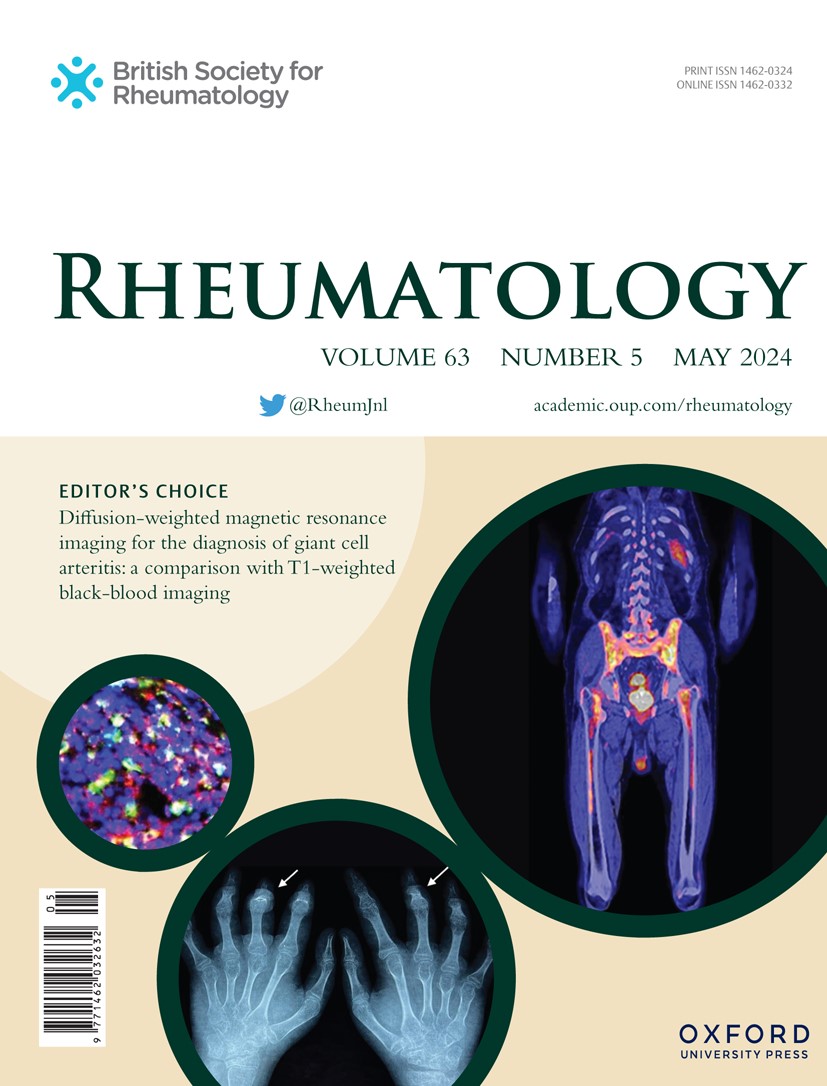Unfolding dermatological spectrum of Still's disease: a cohort study from the International AIDA Network Still's Disease Registry.
IF 4.4
2区 医学
Q1 RHEUMATOLOGY
引用次数: 0
Abstract
OBJECTIVES To investigate cutaneous manifestations in Still's disease patients, evaluating any correlation with ethnic origin, age at disease onset, disease patterns, occurrence of MAS, and systemic activity scores. METHODS Data were retrospectively drawn from the International AutoInflammatory Disease Alliance (AIDA) Network Registry dedicated to Still's disease. RESULTS A total of 518 patients (41.3% males) were enrolled. Salmon-colored evanescent skin rash (n = 304, 63.9%), macules (n = 40, 7.7%), urticarial eruptions (n = 31, 5.9%), erythema (n = 27, 5.2%), and persistent pruritic papules and plaques (PPPP) (n = 25, 4.8%) accounted for the most frequent skin manifestations observed in Still's disease. Overall, atypical skin rash were described in 110 (21.2%) patients. Salmon-colored evanescent skin rash and pruritus were more common among patients aged <16 years compared with patients aged 16-60 (p= 0.002 and p= 0.008, respectively). Pruritus was significantly more frequent among White than among Arab patients (p= 0.008) and in polycyclic vs monocyclic course (p= 0.049). Hispanics showed a significantly higher rate of atypical skin manifestations compared with Arabs (p= 0.036) and White (p= 0.036). Also, macules were more frequent among Hispanics than White (p= 0.027), while PPPP was more frequent among Hispanics than Arabs (p= 0.023) and White (p= 0.002). Salmon-colored evanescent skin rash was significantly more frequent among patients with a systemic activity score ≥7 (p< 0.001). CONCLUSION The present study enhances dermatologists' awareness of the diverse cutaneous lesions that may represent heterogeneous manifestations of Still's disease, shedding new light on the difference related to the age at disease onset, the patients' ethnic origin and the severity of the disease.揭示斯蒂尔氏病的皮肤病学谱:来自国际AIDA网络斯蒂尔氏病登记处的队列研究。
目的研究斯蒂尔氏病患者的皮肤表现,评估其与种族、发病年龄、疾病类型、MAS发生和全身活动评分的相关性。方法回顾性数据来自国际自身炎症疾病联盟(AIDA)网络注册中心,专门用于Still病。结果共纳入518例患者,其中男性41.3%。鲑鱼色短暂性皮疹(n = 304, 63.9%)、斑疹(n = 40, 7.7%)、荨麻疹疹(n = 31, 5.9%)、红斑(n = 27, 5.2%)和持续性瘙痒性丘疹和斑块(n = 25, 4.8%)是Still病最常见的皮肤表现。总体而言,110例(21.2%)患者出现非典型皮疹。与16-60岁的患者相比,<16岁的患者以鲑鱼色的暂时性皮疹和瘙痒更为常见(p= 0.002和p= 0.008)。白种人患者瘙痒明显多于阿拉伯人(p= 0.008),多环疗程明显多于单环疗程(p= 0.049)。与阿拉伯人(p= 0.036)和白人(p= 0.036)相比,西班牙裔患者出现非典型皮肤表现的比例明显更高。此外,斑疹在西班牙裔中比白人更常见(p= 0.027),而PPPP在西班牙裔中比阿拉伯人(p= 0.023)和白人(p= 0.002)更常见。在系统活动评分≥7分的患者中,鲑鱼色的暂时性皮疹更为常见(p< 0.001)。结论本研究提高了皮肤科医生对可能代表Still病异质性表现的多种皮肤病变的认识,揭示了发病年龄、患者种族和疾病严重程度的差异。
本文章由计算机程序翻译,如有差异,请以英文原文为准。
求助全文
约1分钟内获得全文
求助全文
来源期刊

Rheumatology
医学-风湿病学
CiteScore
9.40
自引率
7.30%
发文量
1091
审稿时长
2 months
期刊介绍:
Rheumatology strives to support research and discovery by publishing the highest quality original scientific papers with a focus on basic, clinical and translational research. The journal’s subject areas cover a wide range of paediatric and adult rheumatological conditions from an international perspective. It is an official journal of the British Society for Rheumatology, published by Oxford University Press.
Rheumatology publishes original articles, reviews, editorials, guidelines, concise reports, meta-analyses, original case reports, clinical vignettes, letters and matters arising from published material. The journal takes pride in serving the global rheumatology community, with a focus on high societal impact in the form of podcasts, videos and extended social media presence, and utilizing metrics such as Altmetric. Keep up to date by following the journal on Twitter @RheumJnl.
 求助内容:
求助内容: 应助结果提醒方式:
应助结果提醒方式:


